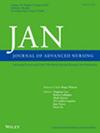在混合方法研究中整合文献、理论和研究数据的拼贴整合程序
IF 3.4
3区 医学
Q1 NURSING
引用次数: 0
摘要
目的提出混合方法研究中文献、理论与研究数据相联系的拼贴整合流程,并举例说明其在两种混合方法研究中的应用。设计讨论论文/研究方法。数据来源拼贴技术是基于两项探索性顺序护士主导的混合方法研究而开发的。拼贴技术需要在一个图形中使用多个人工制品(数据片段、图形和文本信息)。拼贴可以产生相关的前后联系,创造意义,完善推理和元推理。结论本文为整合三部曲的文献综述和理论维度的有意义整合提供了一种新的整合方法。对护理的启示护士研究人员可以使用拼贴整合程序进行有效的整合,以进行严格的混合方法研究。拼贴是一种简单而有效的技术,可以加强文献综述和理论维度的整合。影响将文献综述、理论和研究数据联系起来,有助于对研究结果进行更有意义的解释。虽然研究人员可以通过整合研究的多个维度来创建一个更全面整合的MMR设计,但迄今为止,大多数关于MMR的实证和方法论文献都侧重于设计、实地考察、分析和解释维度的整合,而忽略了其他维度,如文献综述和理论维度。拼贴可以对原始数据进行深入分析,并在整个数据分析和展示中嵌入从文献和理论中获得的见解,从而避免忽视通过来回比较和整合文献综述和理论基础可以获得的见解。患者或公众捐款:无直接患者或公众捐款。本文章由计算机程序翻译,如有差异,请以英文原文为准。
Collaging Integration Procedure for Integrating Literature, Theory, and Research Data in Mixed Methods Research
AimsTo propose the collaging integration procedure for linking literature and theory to research data in mixed methods research (MMR) and illustrate its application in two mixed methods studies.DesignDiscussion paper/research methodology.Data SourcesThe collaging technique was used and developed based on two exploratory sequential nurse‐led mixed‐methods studies.ResultsThe collaging technique entails using multiple artefacts (data fragments, figures and textual information) within one figure. Collaging can generate relevant pre‐post linkages, create meaning and refine inferences and meta‐inferences.ConclusionThis paper offers a novel integration technique for meaningful integration of the literature review and theoretical dimensions in the integration trilogy.Implications for NursingNurse researchers can use the collaging integration procedure for effective integration for conducting rigorous mixed‐methods research. Collaging is a straightforward yet effective technique for enhancing integration in the literature review and theoretical dimensions in MMR.ImpactLinking literature review, theory and research data facilitates a more meaningful interpretation of research findings. While researchers may be able to create a more fully integrated MMR design by integrating multiple dimensions of the study, to date, most of the empirical and methodological literature on MMR has focused on integration at the design, fieldwork, analysis and interpretation dimensions, ignoring others, such as the literature review and theoretical dimensions. Collaging enables intensive analysis of the raw data and embeds the insights gained from literature and theory throughout the data analysis and presentation, thereby avoiding neglecting insights which could have been gained by back‐and‐forth comparison and integration of literature review and theoretical underpinnings.Patient or Public ContributionNo direct patient or public contribution.
求助全文
通过发布文献求助,成功后即可免费获取论文全文。
去求助
来源期刊
CiteScore
6.40
自引率
7.90%
发文量
369
审稿时长
3 months
期刊介绍:
The Journal of Advanced Nursing (JAN) contributes to the advancement of evidence-based nursing, midwifery and healthcare by disseminating high quality research and scholarship of contemporary relevance and with potential to advance knowledge for practice, education, management or policy.
All JAN papers are required to have a sound scientific, evidential, theoretical or philosophical base and to be critical, questioning and scholarly in approach. As an international journal, JAN promotes diversity of research and scholarship in terms of culture, paradigm and healthcare context. For JAN’s worldwide readership, authors are expected to make clear the wider international relevance of their work and to demonstrate sensitivity to cultural considerations and differences.

 求助内容:
求助内容: 应助结果提醒方式:
应助结果提醒方式:


